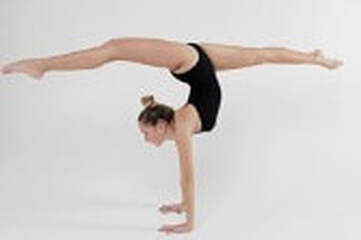|
https://soundbitesrd.com/podcast-episode-192-nutrition-for-ballet-dancers-challenges-opportunities-dr-nasira-burkholder-cooley/
3 Comments
Irritable bowel syndrome, or IBS, is a class of disorders involving gut-brain interaction that affects up to 1 in 10 Americans. Diagnostic criteria includes abdominal pain at least once per week on average over the past three months associated with changes in stool frequency or form. Symptoms affect the large and small intestines and typically include periodic or chronic bloating, diarrhea, constipation, gassiness, and cramping.The cause of IBS is unknown, however genetics, allergies, infection, lifestyle, and gut microbiota may contribute to IBS and stress and certain foods may trigger symptoms. The large intestine has nerves that communicate with the brain, so stress can stimulate intestinal spasms resulting in pain and discomfort. Specific foods can initiate episodes of IBS, and many people with IBS notice that symptoms worsen after consuming high-fat foods or large meals.
Until recently, the medical advice provided to patients with IBS was to reduce stress and eat more fiber. Research has indicated that IBS can be managed with a focus on diet composition and eating habits, possibly with the assistance of medications, probiotics, and stress management. Consider the following modifications to your diet to provide relief from IBS and prevent future flare-ups.
 According to the Center for Disease Control and Prevention, nutrient dense foods are those that provide an average of 10% or more daily value per 100 calories of 17 nutrients, including potassium, protein, fiber, iron and calcium. While there are numerous fruits and vegetables that are nutrient dense, there are some in particular that are best in the summertime because they also happen to be very hydrating. Citrus fruits and berries are excellent choices for summer snacking. According to CDC’s nutrient density approach, the healthiest of them all is the strawberry, with a nutrient density score of 17.6. According to the FDA, strawberries have more vitamin C than any citrus fruit, and are also rich in potassium and fiber. As an added bonus, strawberries are a good source of flavonoids, a group of phytonutrients linked to reduced risk of diabetes, heart disease, and some cancers. Strawberries are about 92% water, a proportion similar to that of watermelon; and, because of their electrolyte content, strawberries are an ideal source of hydration on warm days. If you aren’t a fan of eating a portion of plain fresh strawberries, the flavor of strawberries is delicious when sliced pieces are added to your ice water. There are also many healthy summer recipes, both sweet and savory, that contain strawberries, such as the Caprese Salad with Strawberries recipe below! Refreshing Caprese Salad with Strawberries 2 pounds fresh strawberries, stemmed and halved 2 cups bite-sized fresh mozzarella balls (Bocconcini), drained and halved 2 tablespoons extra virgin olive oil 1/3 cup balsamic vinegar 3-4 fresh basil leaves, finely diced Salt, pepper to taste In medium sized bowl, toss strawberries and mozzarella balls with olive oil. Season mixture with salt and pepper. Add basil and toss again. Drizzle balsamic syrup over and around salad. Grind more pepper on top and serve. References:
A healthy diet takes planning, time, and effort. Having the right foods available when you need them is important for dancers with limited time and intense training schedules. Here are some nutritious food staples recommended for every dancers' kitchen.
5/26/2021 7 Comments Understanding Hypermobility What is Joint Hypermobility? Joint hypermobility refers to greater than normal range of motion in a given joint. Excessive range of motion can be attributed to factors such as bone shape, hormonal influences, impaired proprioception, reduced muscular strength, and decreased collagen strength (Knight 2012). Collagen is a structural protein within connective tissue. Fascia, ligaments, joint capsule, tendons, skin, blood vessel walls, gastrointestinal lining, and respiratory tracts contain connective tissue. Defects in connective tissue proteins contribute to joint laxity and can result in widespread symptoms (Hakim 2015). What are hypermobility disorders? Hypermobility disorders refer to a group of conditions involving symptomatic joint hypermobility. Some hypermobility disorders such as Ehlers-Danlos syndrome are caused by abnormal structure and function of collagen and connective tissue proteins. Hallmark features of connective tissue disorders include stretchy skin, loose joints, and fragile tissues (Simmonds 2007). What are common signs/symptoms of Hypermobility disorders?
Joint hypermobility is common among dancers and rhythmic gymnasts because of the flexibility demands in both disciplines. How do we screen for Hypermobility? The 5-point hypermobility questionnaire, Beighton scale, and Brighton criteria are useful screening tools for hypermobility. Two positive responses on the 5-point questionnaire provides a sensitivity of 84% and a specificity of 85% for detecting joint hypermobility (Kumar 2017). How is Hypermobility diagnosed? Joint hypermobility is identified through a comprehensive patient history as well as a variety of clinical tests. How can Physical Therapy help? Physical therapy can play a vital role in providing treatment strategies for individuals with joint hypermobility to improve joint stability, reduce pain, and improve function. Treatments may include:
References:
Stress is a physiological condition associated with disorders of the nervous, endocrine, and immune systems. Uncovering natural remedies to combat stress continues to be a significant area of scientific research. In traditional Chinese Medicine known as Ayurveda, consumption of adaptogenic herbs is common practice to improve the body’s ability to adjust to exposures such as extreme temperatures, loud noise, strenuous physical exertion, chemical pollutants, and to help maintain cognitive function, blood glucose, lipid levels and blood pressure. Adaptogens are naturally occurring plant compounds or extracts known to exhibit protection against stress, fatigue, anxiety, and depression. According to Selye’s theory (Selye, 1950) the stress response and general adaptation syndrome includes three phases: alarm, resistance, and exhaustion. Recent pharmacological studies of individual adaptogens provide rationale to their effects at the molecular level, indicating several mechanisms of action that help the body maintain equilibrium. However, adaptogens supposedly act non-specifically, and may activate certain energy-producing chemical receptors and deactivate others to prevent overreaction to stress messengers. Combinations of adaptogenic plants may offer unique effects due to their synergistic interactions in organisms which are not achieved by isolated extracts or supplements of individual adaptogens.
The chemical compounds known as adaptogens are typically phenolics or triterpenoids. Phenolics are structurally similar to catecholamines, which activate the stress system in the early stages of stress response. Triterpenoids resemble the corticosteroids that act as stress hormones in deactivation of the stress system. Adaptogens often are included alone or in combinations in bottled beverages, herbal teas, smoothies, plant-based protein powders, and supplements. The following are adaptogens that have demonstrated beneficial health effects:
References: Enyeart JA, Liu H, Enyeart JJ. Curcumin inhibits ACTH- and angiotensin II-stimulated cortisol secretion and Ca(v)3.2 current. J Nat Prod. 2009;72(8):1533-1537. Jamshidi N, Cohen MM. The clinical efficacy and safety of tulsi in humans: a systematic review of the literature. Evid Based Complement Alternat Med. 2017;2017:9217567. Lee S, Rhee DK. Effects of ginseng on stress-related depression, anxiety, and the hypothalamic-pituitary-adrenal axis. J Ginseng Res. 2017;41(4):589-594. Liao, L. Y., He, Y. F., Li, L., Meng, H., Dong, Y. M., Yi, F., & Xiao, P. G. (2018). A preliminary review of studies on adaptogens: comparison of their bioactivity in TCM with that of ginseng-like herbs used worldwide. Chinese medicine, 13, 57. https://doi.org/10.1186/s13020-018-0214-9. Panossian, A., & Wikman, G. (2010). Effects of Adaptogens on the Central Nervous System and the Molecular Mechanisms Associated with Their Stress-Protective Activity. Pharmaceuticals (Basel, Switzerland), 3(1), 188–224. https://doi.org/10.3390/ph301018 Selye H. Stress. Acta Medical Publisher; Montreal, Canada: 1950.  Dancing at home has presented new challenges such as having to adjust to improper flooring and/or investing in new flooring. With this in mind, what flooring is appropriate? What are some indications that I may be dancing on improper flooring? What can I do to modify if I don’t currently have access to good flooring? Good technique and adequate flooring are both crucial for injury prevention. Up to 28% of professional dancers associated an unsuitable floor surface with re-injury (Hopper 2014). A permanent, fully sprung floor is recommended (Quin 2015). This translates into a 2 component structure. The top surface is typically wood or marley in order to provide optimal grip. Too much resistance can create added torque on joints, while lack of friction leads to increased muscular tension and falls. The undersurface/substructure has the shock absorbing properties and typically consists of a solid or suspended subfloor with a dense foam layer underneath (Quin 2015). It is also important to note that raked stages can triple the amount of risk for injury. In addition, floor surface variability versus lack of shock absorbing capabilities may have an even greater influence on injury (Hopper 2014). Therefore, it is important to maintain uniformity of the surface and clean regularly. Improper flooring can contribute to low back pain, sacroiliac dysfunction, stress fractures, shin splints, and tendinopathies. Occurrence of these injuries could indicate improper flooring. If you don’t have immediate access to a sprung floor, you may want to consider the following: jumping in sneakers, avoiding single leg landings, close in first or third position rather than fifth position, and/or train the components of the jumps. References: Hopper, L. S., Allen, N., Wyon, M., Alderson, J. A., Elliott, B. C., & Ackland, T. R. (2014). Dance floor mechanical properties and dancer injuries in a touring professional ballet company. Journal of science and medicine in sport, 17(1), 29-33. Quin, Edel & Rafferty, Sonia & Tomlinson, Charlotte. (2015). Safe Dance Practice: An applied dance science perspective. Pages 8-10. By Erica Hornthal, LCPC, BC-DMT “The Therapist Who Moves You” These days you may find it harder to stay present, especially when being in the moment reminds us that things are not what they used to be. The inability to be present can lead to a decrease in body awareness which has a huge impact on our movement overall.
You have the power to slow down, observe, and take action. By challenging your status quo and moving outside your comfort zone you create greater capacity to handle stress and the emotions that come with it. Think of it as your emotional gas tank. Adding to your movement profile, or all the movement at your disposal, creates a larger reserve which means less breakdowns on the side of the road as well as less trips to the gas station. When you increase your movement and body awareness you get more emotional miles per gallon. So how do you maximize your emotional miles per gallon through movement to support resilience and overall well-being? Here are some tips:
Looking for more support? My workbook, Body Awareness for Mental Health, is for you! Rooted in theories and methodologies from the field of dance/movement therapy this workbook is designed for:
1/2/2021 8 Comments Healthy Happy New Year RecipeWe’ve made it through the year 2020 and it is time for a new beginning and fresh perspective. Here is a delicious and healthy recipe to help you launch 2021! This vegetarian dish includes protein, fiber, and anti-inflammatory phytochemicals. It is also zesty and satisfying - enjoy!
Spiced Black-Eyed Peas with Coconut Milk - recipe makes 6 servings 2 cups dried black-eyed peas Dash salt 3 tbsp. canola oil 1 large red onion 1 1/2 tbsp. fresh ginger 3 cloves garlic 1 habanero chile 1 tsp. ground turmeric 3 medium tomatoes 1 cup light coconut milk 1 cup low-sodium broth 1 cup fresh cilantro 2 green onions
As dancers return to the studio, it is important to gradually introduce jumps to prevent lower leg injuries. Foot and ankle injuries are often incurred during dynamic movements like jumping, and improper flooring, poor technique, and fatigue can increase the risk of injury.
Here are some important tips to lessen the likelihood of sustaining injury during jumps:
References: Russell J. A. (2013). Preventing dance injuries: current perspectives. Open access journal of sports medicine, 4, 199–210. https://doi.org/10.2147/OAJSM.S36529 |
CategoriesAll Cross Training Injury Prevention Nutrition Recipes Wellness Archives
October 2021
|

 RSS Feed
RSS Feed